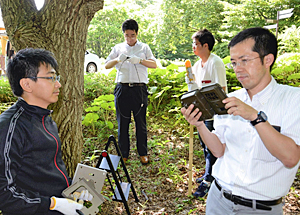AI sentinel learning to detect bears(AIでクマ発見、周知へ)

A team of researchers led by Hiroshi Saito, a senior associate professor at the University of Aizu, is developing an artificial intelligence system to detect the whereabouts of potentially harmful wild animals, such as bears, and to notify people via email of the presence of animals nearby.
To start, the researchers chose bears as the subject of the detection.
If the system is put into practical use, it could reduce damage to agricultural crops and fears about harm to humans.
会津大の斎藤寛上級准教授らの研究チームが人工知能(AI)を活用して特定の動物を感知、位置情報をメールで配信する「野生動物検出システム」の研究開発を進めている。まず、対象動物としてクマを選んで研究する。実用化できれば農作物の被害や人に対する不安の軽減につながり、農村や都市部の安全確保へと期待が掛かる。
On July 9, the team of researchers began a demonstration test to detect the locations of bears in Aizu Recreation Park in Aizuwakamatsu, Fukushima Prefecture.
Four researchers, including Saito, set up an automatic camera on a tree near a botanical garden in the park, where bears have been spotted.
The camera detected body temperature and movement from about 10 meters away, and took photos of the objects. The researchers confirmed that the photos were transmitted to their smartphones and university computers.
研究チームは9日、会津若松市の会津レクリエーション公園でクマの感知に向けた実証実験を開始した。斎藤上級准教授ら4人が、クマの目撃があった同公園湿性植物園近くの木に自動撮影カメラを設置。約10メートル先の体温や動きを感知したカメラが対象物を撮影し、スマートフォンや同大のパソコンに送信するのを確認した。
The team's research is a part of the Strategic Information and Communications R&D Promotion Program (SCOPE), which is a project of the Internal Affairs and Communications Ministry mainly for technological developments in fields of information and communication technology.
In addition to Saito, who is the team's representative, Yoichi Tomioka, an associate professor, and Yukihide Kohira, a senior associate professor, participate in the team of researchers.
A researcher on the team said that the research and development program for detecting wild animals is rare in the nation in that the system includes distribution of emails.
研究は情報通信技術(ICT)分野の技術開発などを目指す総務省の「戦略的情報通信研究開発推進事業」(SCOPE)の一環。研究チームは研究代表者の斎藤上級准教授に富岡洋一准教授と小平行秀上級准教授が研究分担者として加わる。研究チームによると、メール配信を含んだ野生動物検出システムの研究開発は、全国でも珍しいという。
In the system, a combined set of sensors to detect animals, the small camera, a computer system, wireless equipment and other tools will be set up at the observation location.
But one hurdle is that burdens on the computer system will be heavy, because the computer system will have to process a huge volume of data if all of the graphic information detected by the sensors is input.
システムでは動物を感知するセンサーや小型カメラ、コンピューターシステム、無線関連機器などを一体化した検出端末を現場に設置するが、センサーが感知した画像情報全てを入力していては大量のデータ処理などに伴うコンピューターシステムの負担が問題になってくる。
The team of researchers aims to resolve the issue by utilizing the AI technology of machine learning.
An AI program, in which tens of thousands of pieces of graphic data of bears is accumulated, is installed in the detection system, so that the system will be able to detect and photograph only bears.
By changing the kinds of graphic data accumulated in the AI program, the detection system can be used also to detect other animals, such as boars and deer.
研究チームはAI技術の一つ「機械学習」の活用で課題の解決を目指す。数万枚のクマの画像データを蓄積したAIをコンピューターシステムに組み込み、クマだけを感知、撮影することができるようにする。AIに蓄積する画像データの種類を変えれば、イノシシやシカなどほかの動物にも応用が可能だ。
Information about detection of bears is distributed to local governments, police, nearby schools and local residents via a server in the university.
People can access the information around the clock on a website or on their smartphone screens. The team of researchers is also trying to develop a system that will display the times and places of appearances of bears together with maps.
検出情報は同大に設置したサーバーを通して自治体や警察、近隣の学校、市民らへ配信される。配信された情報はWebページやスマートフォン上で24時間閲覧ができる。クマの出没時間や場所などが地図付きで表示できるような仕組みづくりにも挑む。
The team of researchers anticipates that the detection devices will be set up in such places as border zones between mountains and residential areas, and areas along rivers.
The team aims to complete the development of the detection devices by the end of this fiscal year.
検出端末の設置場所は山あいと住宅地の境や川沿いなどを想定。センサーは約6~10メートル先の対象動物を感知することができるという。検出端末の年度内完成を目指す。
Saito said that if the system is realized: "Damage by wild animals can be reduced. It can also wipe out fears among local residents, especially children, and make them safer."
( Translated by The Japan News )
斎藤上級准教授らは「(実用化できれば)野生動物の被害を減らせる。子どもたちなど市民の不安を払拭(ふっしょく)し、安全の確保につながる」と開発を急ぐ。
【 2018年7月6日、10日付・福島民友新聞掲載 】
- Futaba Post Office reopens after 13 years(双葉郵便局、13年ぶりに再開)
- Craft sake brewery to make unmanned station more welcoming(無人駅の「クラフトサケ」醸造所がお出迎え)
- New Kitakata ramen developed to appeal to foreign tourists(訪日客向けの喜多方ラーメン開発)
- Aizu-Wakamatsu students come together with teahouse project(会津若松の生徒、茶室プロジェクトに集結)
- New hotel to be symbol of reconstruction(復興のシンボルとなる新ホテル)
- Radiation-resistant cameras to be produced in Fukushima(耐放射線カメラ、福島県で生産へ)
- International flights to Fukushima to resume after 13-year hiatus(福島の国際定期便、13年ぶり再開へ)
- Fukushima association to create base for parents of children with disabilities(障害児の親へ拠点作り)
- Real shell mound from Jomon period goes on display in Minami-Soma(南相馬で縄文のリアル貝塚展示)
- Japanese man opens restaurant to provide free meals to residents of war-hit Ukraine city(日本人男性が戦禍のウクライナに無料レストラン開店)